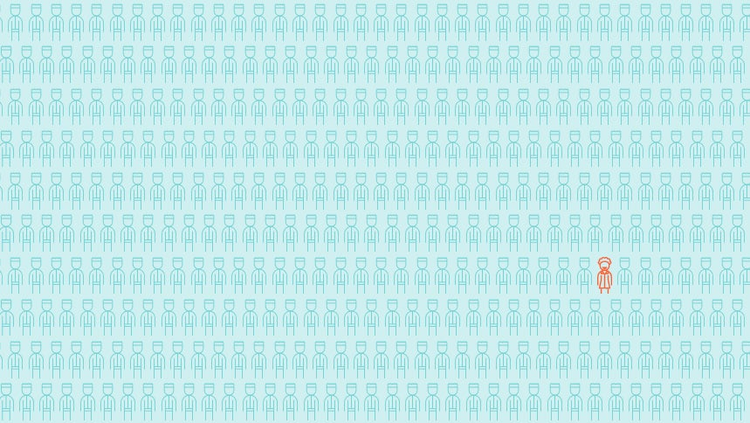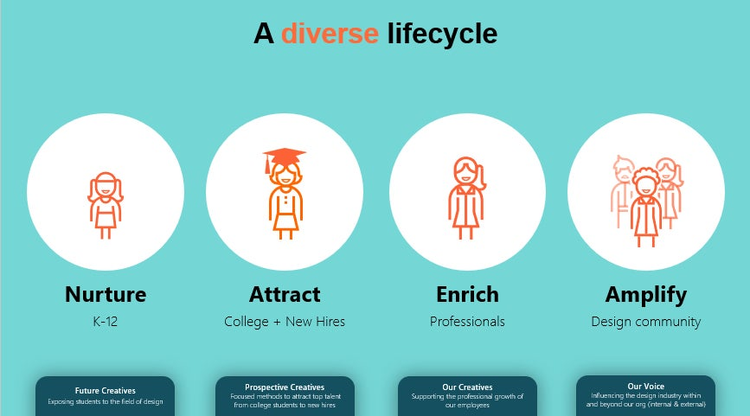Diversity has become a hot topic in our world, and we’ve moved into a moment in our country in which the word “inclusivity” in the workplace has become not just a talking point but a call to action for real change. Representation matters, especially when it comes to creating product experiences our customers love. Our consumers not only want to feel heard, but they also want to be recognized for their individuality. I understand this desire as a design leader of color, and it’s why I am passionate about changing how we approach diversity and team building.
Diversity in design is essential to creating better teams and products. In the United States, three percent of designers are Black, just 20 percent of women work in the tech industry, and only 11 percent of those women have leadership roles. This lack of diversity holds us all back from brighter futures and better outcomes. We have an incredible opportunity to create meaningful change — to empower diverse people with unique experiences and voices.
I realize creating a thriving, diverse team culture may seem too great a feat to conquer. All of this can seem like an overwhelming task for a design leader. I’m here today as living proof that no obstacle you face is insurmountable if you’re willing to do the work. I’ve worked to define and refine methods for more inclusive design team building.
Who’s (going to be) the boss: The importance of mentorship
I was always a creative child growing up, and I knew early on that I wanted to work in design and marketing. I poured myself into my dream of becoming a designer, honing my creative skills, but I soon realized there was no one who looked like me in the field I desired that I could aspire to besides Angela Bower, from Who’s The Boss — a blond marketing executive. She became my role model for a creative career woman going after the American success story. I wanted to be her, but I was acutely aware that my career path would not mirror Angela Bower’s as a young black creative.
And why I’ll say again — representation matters. Society, in general, really underestimates the value of children (of all colors, shapes, social classes, and personalities) being able to see a version of themselves in different careers. Choosing a career and following your passion can feel impossible when you see the majority of bosses, managers, and leaders are white in the role you try to imagine for yourself as a child. This disconnect can and does have an impact on one’s career choices.
Everyone needs a mentor, a role model in their lives, who can help you make the right decisions. Mentors are often key to success, and it’s important to connect and learn from mentors that look like you.
So let’s talk about how to find diverse candidates in the design and technology sectors — and how to adapt our current processes to amplify those voices struggling to be heard. Let’s explore how to redesign team diversity and culture with actionable measures that can be implemented to ensure diversity and inclusivity are not just buzzwords but genuine goals your team can work toward.
The diverse lifecycle as a long-term solution
In my role at Microsoft, I’ve worked to define and refine methods for more inclusive design team building, as I’ll be sharing in my talk at Adobe MAX. Making a change in your team or organization often starts with a conversation — a conversation you’ve likely been a part of. It usually starts like this: “We want to hire a Black person,” or “We need to hire a more diverse team.”
Your first thought might be, “What a great step! We’re well on our way to building a diverse team!” You begin to look through potential applicants, but there are no BIPOC (Black, Indigenous, people of color) candidates. So, how do you hire diverse talent with a monochromatic applicant pool?
Through research and my own experiences as a Black designer, I’ve discovered that our existing recruiting processes just don’t work. This is because we’re skipping the first stage of what I call the “diverse lifecycle” with K-12 students, our future creatives.
Stage 1: Nurture diverse students
To get a more diverse hiring pool, we first need to start by exposing diverse students to the art and industry of design. This way, 10 years from now, we will have a diverse group of students ready to build their creative careers. If I had been nurtured in school, I would have known there were more creative women to aspire to besides Angela Bower. If we can institute this systematic process, I am confident we will end up with stronger, more diverse design teams.
Stage 2: Attract college grads and new designers
The next stage of the diverse lifecycle is how to attract college grads and new hires. This has to be intentional. It’s a key component because these are the prospective creatives coming into our workforce. Neglecting the budding creative in this stage has resulted in a lack of diversity in the tech and design sector.
Stage 3: Enrich the work lives of diverse creatives
We need to continually work to improve and enrich the work lives of diverse creatives. I’ve often heard many stories from people of color who have made the decision to leave a creative career because of a lack of support. Creating opportunities such as mentorship is critical in this stage.
Stage 4: Amplify diverse voices
The last stage of the diverse lifecycle is all about amplifying. This is where the entire design community comes in. That’s me, and you, writing and speaking on a public stage. This is how we get diverse representation that is externally visible — outside the studio, in our design community, and within our organizations. Together, we must work to amplify the voices of diverse creatives.
The importance of team diversity
Diverse teams are more creative and offer a richer, more collaborative experience for all involved. And diverse teams produce products with a better understanding of the diverse consumers they serve. In fact, being part of a diverse team is a crucial factor many millennials assess when considering a role at a new company. Today, people desire to work for a company and be a part of a team that reflects diversity and a willingness to build team culture. Building a healthy, diverse team culture is just as important as the work that team produces. And I can attest to the fact that productivity increases when your team feels connected, represented, and supported. In short, diverse teams are a win, win, win.
The diverse lifecycle provides steps you can take now to build a diverse team with a team culture that honors every voice. As I’ve learned working at a tech company, it can’t just be about the feels. I know you’ve got to bring the numbers too. Having a diverse team also adds to the bottom line. One of my favorite stats really hammers the value of diversity in tech home — more diversity in the IT industry has the potential to net an extra $400 billion in revenue each year. Simply put, diversity makes financial sense, too.
Treat team culture like a product — just hack it
At Microsoft, when working on a new project, you always start with version 1. Most V1s in any product are often trash, but valuable trash. You will learn and grow as a product team after you receive real-time feedback. And, inevitably, you’re probably going to throw it out, but V1s are where you start. V1s give you an opportunity to learn and grow.
It’s the same with diversity efforts — people often feel like their first effort, or V1 should be perfect — it won’t be. So many leaders are passionate about creating team diversity but get tangled up in the fear of making a mistake. I urge you to push past this stumbling block. Just as we rarely perfect any design or idea in V1, it may take many rounds of feedback and empathetic collaborations to build upon current diversity efforts. It’s okay to have a V2, V3, etc. (until you finally end up with V12FinalFinalEditedFinal, naturally).
Design your diversity efforts with the same rigor you design your products. Go for it, open up a dialogue, and invite feedback on your initial attempts. Take time to listen and be open to change your changes! Remember, when something doesn’t work, there’s always something to learn. Have a post-mortem so you can walk away with a better understanding of the direction you need to go next.
No one is nailing it
Working toward an industrywide shift such as this one isn’t going to be easy. We won’t always get it right, but there are pockets of goodness happening already. As a creative, I’ve been inspired and encouraged to see people working to tackle the complex issue of diversity in tech with many different solutions. If we know anything about design, it’s that the most efficient way to work is to look for existing patterns, then look for ways to evolve them. Collectively, we should look for patterns, and learn from the wins and missteps within our industry.
As a design community, we need to seek out more opportunities to learn and grow from each other and use our collective knowledge to improve hiring and team-building practices. Because no one is nailing it. Enacting change and creating a better future must be a collaborative effort. And I know if we work together, we will be able to look back at this moment in our history and be amazed by our efforts and the diverse creative world that we’ve built together.



